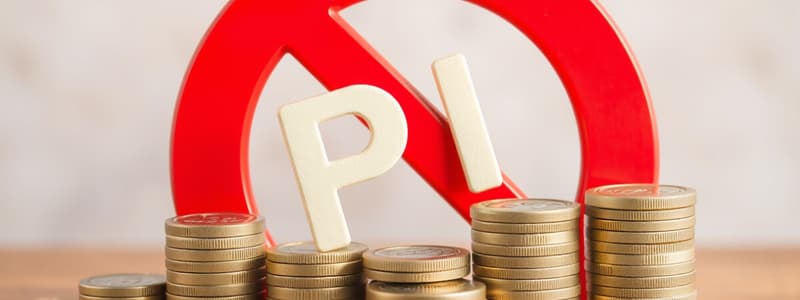Podcast
Questions and Answers
What does a 10% inflation rate signify?
What does a 10% inflation rate signify?
- Prices remain unchanged compared to the previous period.
- Prices increased by 10% compared to the average prices of the last year.
- Prices increased by 10% from the previous period. (correct)
- Prices decreased by 10% from the previous period.
The Producer Price Index (PPI) measures changes in retail prices.
The Producer Price Index (PPI) measures changes in retail prices.
False (B)
What is the formula to calculate inflation using CPI for December?
What is the formula to calculate inflation using CPI for December?
CPI 2013 - CPI 2012 / CPI 2012 * 100
The _____ consists of capital and intermediate goods for the PPI calculation.
The _____ consists of capital and intermediate goods for the PPI calculation.
Match the following terms with their descriptions:
Match the following terms with their descriptions:
What is the inflation rate calculated for the year 2016 based on the provided CPI values?
What is the inflation rate calculated for the year 2016 based on the provided CPI values?
The average inflation rate calculated from monthly indices is subject to fluctuations.
The average inflation rate calculated from monthly indices is subject to fluctuations.
In the CPI calculation, what does the term 'CPI 2016 - CPI 2015' represent?
In the CPI calculation, what does the term 'CPI 2016 - CPI 2015' represent?
What does the GDP deflator measure?
What does the GDP deflator measure?
Real GDP reflects the true value of goods and services by adjusting for inflation.
Real GDP reflects the true value of goods and services by adjusting for inflation.
What formula is used to calculate the GDP deflator for a given year?
What formula is used to calculate the GDP deflator for a given year?
The inflation rate can be calculated using the formula ______.
The inflation rate can be calculated using the formula ______.
Which of the following is NOT a method for diagnosing inflation?
Which of the following is NOT a method for diagnosing inflation?
Calculate the GDP deflator for 2016 with the given values: Nominal GDP = 1098714, Real GDP = 661147.
Calculate the GDP deflator for 2016 with the given values: Nominal GDP = 1098714, Real GDP = 661147.
___________ inflation occurs when aggregate demand increases while aggregate supply remains unchanged.
___________ inflation occurs when aggregate demand increases while aggregate supply remains unchanged.
Match the type of inflation with its description:
Match the type of inflation with its description:
What effect does inflation have on social and political stability?
What effect does inflation have on social and political stability?
Restrictive monetary and fiscal policies are effective in controlling cost-push inflation.
Restrictive monetary and fiscal policies are effective in controlling cost-push inflation.
What is the main strategy for combating demand-pull inflation?
What is the main strategy for combating demand-pull inflation?
____ inflation may lead to a self-fulfilling prophecy of further inflation.
____ inflation may lead to a self-fulfilling prophecy of further inflation.
Match the type of inflation with its corresponding strategy:
Match the type of inflation with its corresponding strategy:
What is indicated by the phrase 'too much money chasing too few goods'?
What is indicated by the phrase 'too much money chasing too few goods'?
Cost-push inflation can be effectively countered by monetary policy.
Cost-push inflation can be effectively countered by monetary policy.
Name one factor that causes cost-push inflation.
Name one factor that causes cost-push inflation.
An increase in aggregate demand (AD) is represented by an increase in C, I, G, and X in the formula AD = C + I + G + X - Z. Fill in the blank: AD stands for _____ .
An increase in aggregate demand (AD) is represented by an increase in C, I, G, and X in the formula AD = C + I + G + X - Z. Fill in the blank: AD stands for _____ .
Match the following concepts with their definitions:
Match the following concepts with their definitions:
Which policy is NOT effective in combating cost-push inflation?
Which policy is NOT effective in combating cost-push inflation?
What happens to total production during cost-push inflation?
What happens to total production during cost-push inflation?
An increase in aggregate demand can lead to higher employment only if there are unemployed resources available.
An increase in aggregate demand can lead to higher employment only if there are unemployed resources available.
What is the primary objective of inflation targeting?
What is the primary objective of inflation targeting?
Inflation targeting was introduced in South Africa in 2005.
Inflation targeting was introduced in South Africa in 2005.
What monetary policy instrument does South Africa use to control inflation?
What monetary policy instrument does South Africa use to control inflation?
The ______ curve illustrates the inverse relationship between inflation and unemployment.
The ______ curve illustrates the inverse relationship between inflation and unemployment.
Match the following terms with their descriptions:
Match the following terms with their descriptions:
What happens when unemployment is reduced to zero according to the trade-off in the Phillips curve?
What happens when unemployment is reduced to zero according to the trade-off in the Phillips curve?
The inflation target range for South Africa is between 1% and 3%.
The inflation target range for South Africa is between 1% and 3%.
What major economic condition was illustrated by the rightward shift of the short-run Phillips curve in the 1970s?
What major economic condition was illustrated by the rightward shift of the short-run Phillips curve in the 1970s?
Flashcards are hidden until you start studying
Study Notes
Inflation Rate Measurement
- Inflation measured monthly allows for any 12-month average comparison.
- A 10% inflation rate indicates a 10% increase in the general price level compared to a previous period.
Calculation Methods for Inflation
-
Method 1: Year-on-Year Comparison
- Calculate inflation by comparing December CPI of two consecutive years.
- Formula: (CPI current year - CPI previous year) / CPI previous year × 100.
- Example: For December 2013, CPI grew from 100.0 to 105.4, resulting in a 5.4% inflation rate.
-
Method 2: Annual Average Calculation
- Average the CPI of all months of the year for comparison.
- Formula: (Avg current year - Avg previous year) / Avg previous year × 100.
- Example: 2013 average CPI of 103.4 compared to 2012's 97.8 yields a 5.7% inflation.
Producer Price Index (PPI)
- PPI measures the cost of production rather than consumer prices.
- Comprises capital and intermediate goods.
- Reflects changes in wholesale prices.
GDP Deflator
- An implicit index representing the difference between nominal and real GDP.
- Nominal GDP is calculated using current prices, while real GDP adjusts for inflation effects.
- Formula for GDP deflator: (Nominal GDP / Real GDP) × 100.
- Used to derive inflation from year-to-year GDP changes.
Causes of Inflation
- Diagnosed mainly through three approaches:
- Demand-pull and cost-push factors.
- Structural approach linked with underlying economic vulnerabilities.
- Conflict approach addressing social and political implications of inflation.
Demand-Pull Inflation
- Caused by increased Aggregate Demand (AD) while Aggregate Supply (AS) remains unchanged.
- Triggered by growth in consumption (C), investment (I), government spending (G), or exports (X).
- Associated with increased money supply resulting in higher price levels when the economy is near full employment.
Cost-Push Inflation
- Arises from higher production costs leading to reduced supply.
- Factors include wage increases, rising import costs, profit margin hikes, decreased productivity, and natural disasters.
- Results in stagflation, characterized by inflation and rising unemployment.
Structuralist Approach
- Emphasizes demand-pull and cost-push inflation in a broader economic context.
- Identifies underlying vulnerabilities, such as fiscal discipline and public sector size.
- Explores income redistribution effects through taxes, particularly during inflationary periods.
Social and Political Effects of Inflation
- Persistent inflation breeds expectations of future increases, potentially leading to hyperinflation.
- Can create social unrest and diminish overall economic progress.
Anti-Inflation Policies
-
For Demand-Pull Inflation:
- Implement restrictive monetary and fiscal policies to reduce aggregate demand.
- Strategies include increasing taxes and interest rates while decreasing government spending.
-
For Cost-Push Inflation:
- Restrictive policies are generally ineffective as they may worsen unemployment and economic downturns.
- Increasing supply sources is preferred despite rising costs.
-
Indexation:
- Adjusts prices and wages according to inflation indicators like CPI to mitigate inflation's impact.
-
Inflation Targeting:
- A central bank sets a target inflation rate and adjusts monetary policy (interest rates) to achieve it.
- In South Africa, the inflation target range is set between 3% and 6%, aiming for price stability.
Phillips Curve
- Illustrates the inverse relationship between inflation and unemployment.
- Lower unemployment correlates with higher inflation rates, presenting a trade-off in economic policy decisions.
Stagflation
- Occurred during the 1970s, characterized by rising inflation alongside rising unemployment.
- Illustrated by the rightward shift in the short-run Phillips curve.
Studying That Suits You
Use AI to generate personalized quizzes and flashcards to suit your learning preferences.




